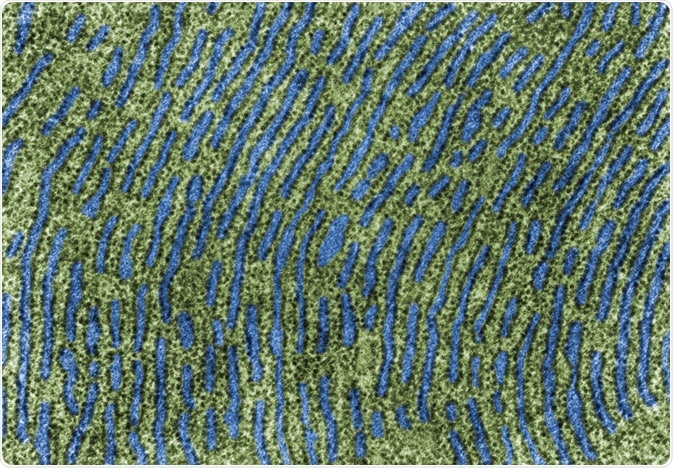What is the endoplasmic reticulum?
The endoplasmic reticulum is the single largest membrane-bound organelle found inside eukaryotic cells. Its complex structure containing tubules, sheets, and matrices mirrors its complex and diverse roles in a selection of biochemical processes, including autophagy.
 Image Credits: Jose Luis Calvo / Shutterstock.com
Image Credits: Jose Luis Calvo / Shutterstock.com
Exactly how this elaborate network of organelles is maintained, generated, disassembled, and restored is still under scientific investigation. Recent studies have shown that, by observing this complex biochemical process, these studies could pave the way towards potential novel treatments for a variety of diseases and infections.
Why does reticulophagy occur?
Reticulophagy is the process responsible for the specific sequestration of components inside the endoplasmic reticulum alongside the associated ribosomes. A vast majority of eukaryotic cells contain a distinguishable amount of endoplasmic reticulum, as it is vital for the synthesis of proteins found within the plasma membrane, and proteins present within any extracellular matrices.
Although several processes, such as the detoxification of drugs, Ca2+ storage, and fatty acid and steroid biosynthesis all occur inside the smooth endoplasmic reticulum, a majority of the folding and post-translational processing of the secreted and membrane-bound proteins take place in all of the endoplasmic reticulum.
Ribosomes that are found free within the cytosol have been mainly observed to translate proteins intended to stay inside the cytoplasm, similarly to ribosomes that are associated with the endoplasmic reticulum membrane that can synthesize proteins that mainly reside inside one of the organelles within the endomembranous system.
Selective autophagy serves as the most vital quality control process that maintains the appropriate turnover of harmful or exhausted organelles, including the endoplasmic reticulum. A recent discovery of endoplasmic reticulum-resident proteins that are capable of binding to mammalian Atg8 proteins has proven that the selective degradation of endoplasmic reticulum involves several receptors that are specialized for different endoplasmic reticulum stresses or subdomains.
How does reticulophagy work?
Autophagy is a process that targets various components within the cell, such as nucleic acids, proteins, and organelles via degradation inside the vacuoles or lysosomes. This process is made up of three categories: microautophagy, macroautophagy, and chaperone-mediated autophagy.
Macroautophagy is widely regarded as the most extensive and active form of this process, which can actively break-down damaged organelles and intracellular misfolded protein. Compared with macroautophagy, the process of microautophagy can be initiated in the absence of functional core autophagy components.
These different types of reticulophagy have been studied to a point where we know what they do, but are yet to fully distinguish how the significant differences between them could be relevant to possible novel disease therapy development.
Confocal imaging studies have previously shown that in cells that possess moderate aggregation conditions, the aggregates of endoplasmic reticulum-targeted p62 mutants were appropriately sequestered by the present autophagosomes, characterized by omegasome marker DFCP1, the co-localization alongside the autophagosome precursor marker ATG16L1, as well as the final autophagosomal marker LC3/GATE-16.
Furthermore, time-lapse imaging data that was collected during this study clearly portrayed that the LC3- or DFCP1-positive protein aggregates can be closely associated with the core structures of the endoplasmic reticulum, thus making the suggestion that reticulophagy occurs at the endoplasmic reticulum itself, and that omegasomes are likely to be involved in this complex biochemical process.
Can reticulophagy be used to treat diseases?
Biological stressors, such as hypoxia, starvation, inflammatory stimuli, infection, drugs, and oxidative stress result in stress within the endoplasmic reticulum, which could initiate reticulophagy.
Endoplasmic reticulum stress plays a crucial role in several pathophysiological events such as neurodegenerative diseases, tumorigenesis, fatty liver, cardiovascular disease, diabetes, antigen presentation, defenses against intracellular pathogens, and cell longevity.
It is therefore speculated that the process of reticulophagy, which is the main contributor to the protein quality control process inside the endoplasmic reticulum, may also be linked to these diseases. For instance, using drugs that target the reticulophagy system within the trabecular meshwork has been shown to play a vital role in the treatment of glaucoma.
Candida albicans autophagy has also been found to alleviate endoplasmic reticulum stress and is also associated with tolerance to antifungal medications. Under endoplasmic reticulum stress-related conditions, fungal cells have been found to evolve multifaceted systems as a response to this stress – including reticulophagy.
In conclusion, the findings from these varied scientific studies suggest that reticulophagy could pave the way for novel promising therapies for diseases such as eye conditions and fungal infections. Furthermore, their receptor proteins (such as Atg40 and FAM134B) could be promising contenders for drug screening and other detection practices.
Sources
Mochida K. and Nakatogawa H. (2015). Reticulophagy and nucleophagy: New findings and unsolved issues. doi: 10.1080/15548627.2015.1106665
Stolz A. et al. (2018). ER-phagy at a glance. doi: 10.1242/jcs.217364
Yeganeh B. et al. (2015) Autophagy: Cancer, Other Pathologies, Inflammation, Immunity, Infection, and Aging. www.sciencedirect.com/.../autophagy-cancer-other-pathologies-inflammation-immunity-infection-and-aging
Wang L. et al. (2017). Visualization of reticulophagy in living cells using an endoplasmic reticulum-targeted p62 mutant. Doi: 10.1007/s11427-015-9037-4
Li L. et al. (2016). Receptor-mediated reticulophagy: a novel promising therapy target for diseases. https://doi.org/10.1093/abbs/gmw057
Further Reading
Last Updated: Jun 16, 2020